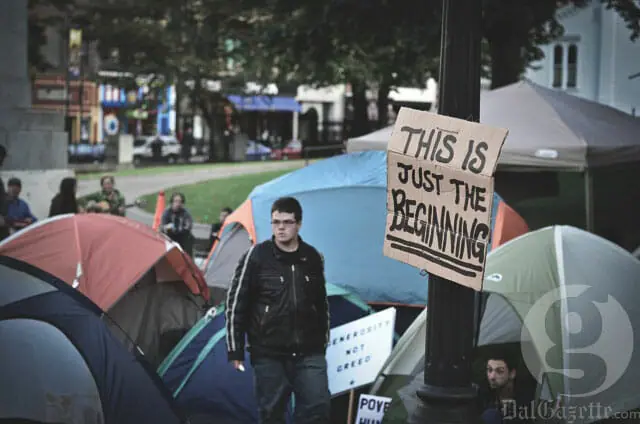If the Occupy movement is going to survive, it must focus on everyday actions
With files from Anika Roberts
All citizens in this country, especially here in the Maritimes, know what it’s like to feel the Canadian cool. By “cool” I mean the relatively laid-back, easygoing culture that has been a part of our identity for a very long time.
So maybe it wasn’t surprising that less than 400 people showed up at the Occupy Nova Scotia protest in Grand Parade Square on Oct. 15.
I get it. People are busy. I myself left halfway through the day to go to work. But the time I was able to spend there was tentatively encouraging.
I’m no veteran protester, but I’ve carried a banner or two in my time, and something about this protest was different. Young families stood chatting with scruffy students, elderly couples held hands and looked at the Solidarity Halifax leaflets being distributed to the crowd. And a huge number of people, for the first couple of hours, sat in the sun on the perimeters of the square, just watching things unfold.
Walking through the crowds, I could hear the questions being passed back and forth: ‘Why are you here?’ ‘Where do you work?’ ‘Why does that guy have a black balaclava on his face?’
Though they appeared more passive than those who were in the thick of the demonstration, these perimeter protestors are those who represent the most hope for this movement. They are the people who saw a bit of truth in the vision, whose curiosity was enough to get them out of bed on a Saturday morning. They are the people with which the discussion will grow, because unlike those deeply involved, they were there to be convinced.
Of course, the issue now is whether this group will continue to expand, or if it has peaked with the number of protesters at Grand Parade Square on Saturday. The answer will depend on the movement’s ability to incorporate its principles into the everyday lives of those sitting on the fringe of the protest.
The goal of this movement is to protect the interests of the 99 per cent. I’d bet that 99 per cent of the 99 per cent don’t have a lifestyle that enables them to hang out in their city’s financial district for weeks at a time.
A movement that claims to be working for the average citizen should reflect the lives of that group. These demonstrations have been hugely successful in garnering media attention and discussing the issues surrounding the protests; but if this movement is to survive, it must shift its focus to small, daily actions in which the 99% of the 99% can participate.
At Saturday’s protest, one speaker called for a start to the conversation that we have been avoiding for so long. It has begun, but it has to be followed by real action if we want to see real change. For the 99% of the 99%, this could simply mean talking to someone about this movement, or avoiding shopping at big businesses. Maybe even taking twenty minutes every few years to cast a vote. The point is, this movement doesn’t necessarily have to be another Arab Spring in order to work.
If the Occupy movement is going to gain steam, its vision needs to be part of the way the 99% conduct their daily lives. The change can come from the level at which we want change affected. Whether or not we can actually take this step remains to be seen.


Recent Comments